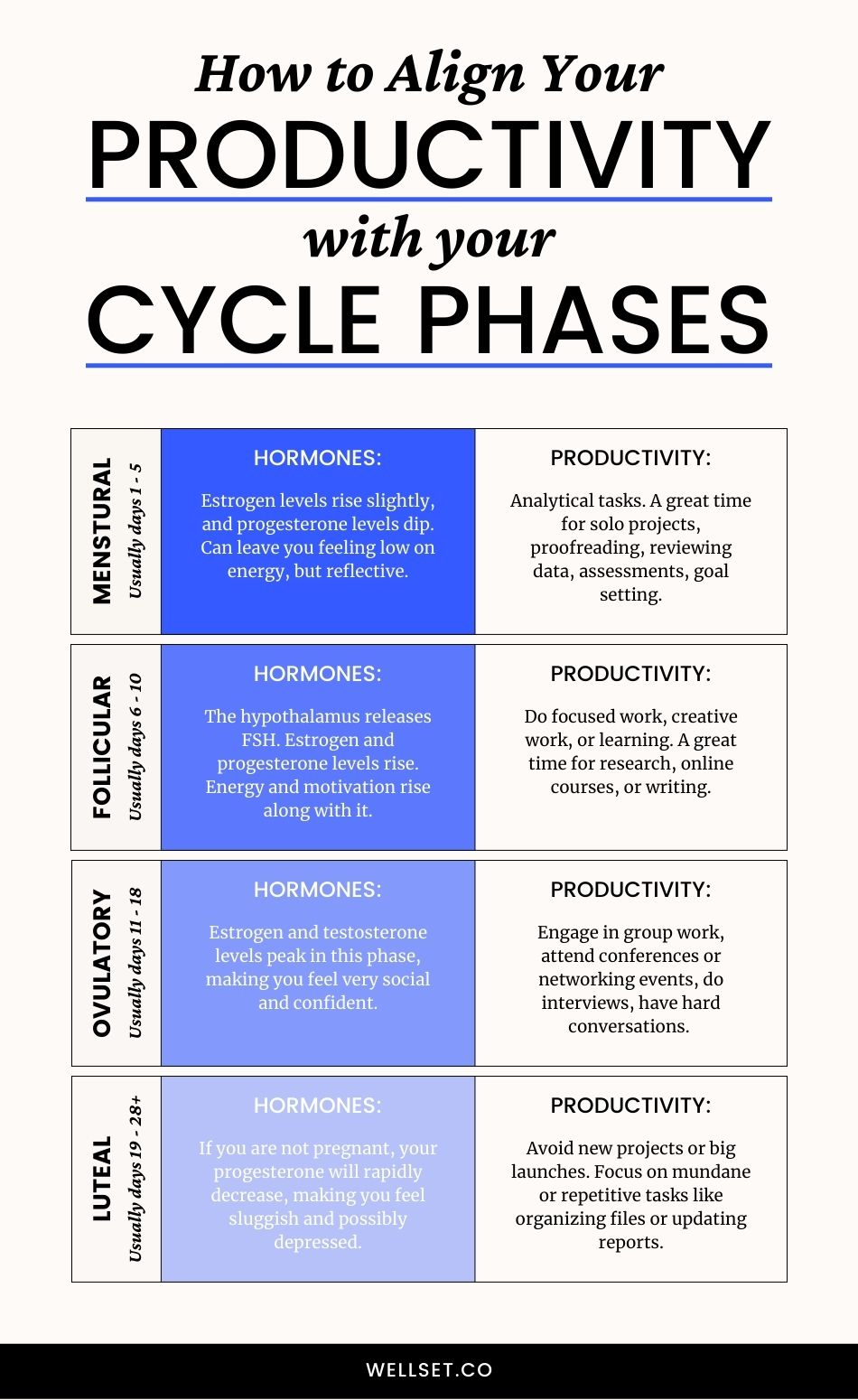Did you know that your menstrual cycle can introduce four unique phases each month — and that certain types of work tasks could be easier or harder during each of those phases?
Syncing my work up with my cycle didn’t just make me more creative and productive, it also reduced frustration and overwhelm. If you’re feeling like your work could use a bit of alignment, here are my best productivity tips for your menstrual cycle.
Cycle Crash Course
First, a quick crash course in the menstrual cycle: Day 1 of your cycle is the day your period starts (not spotting, but the first day of full blood), and progresses into each phase from there. Most menstruating people have a cycle that is around 28-31 days, so generally each phase will last 5-10 days. However, each phase can be unique and tracking is the only way to determine how your body operates.
It’s also important to note that hormonal birth control can alter the experience of your cycle and its phases. The shifts between phases are typically more prominent for people experiencing a natural cycle, without hormonal birth control or other hormone treatments. However, even people who have experienced peri-menopause, menopause, or have a cycle induced by hormone treatments or birth controls can benefit from cycle syncing.

Menstrual Phase (usually days 1-5)
What’s happening in this phase: Menstruation is when your body sheds the thickened lining of the uterus. During menstruation, your estrogen levels rise slightly, and your progesterone levels dip.
What that means for productivity: Energy can be low during menstruation and many of us seek solitude; we can also be incredibly reflective. That means we are primed for tasks that require us to be analytical. It can be a great time for solo projects, proofreading content or reviewing reports.
Follicular Phase (usually days 6-10)
What’s happening in this phase: This is when the hypothalamus releases a little bit of follicle-stimulating hormone (FSH). This hormone stimulates the ovary to release an egg. Estrogen and progesterone levels rise during the follicular phase.
What that means for productivity: The increase in estrogen can increase your energy and motivation, which means this is your week to get sh*t done. You’ll likely find that you are super focused and enjoy doing tasks that are creative, require you to learn new things, absorb large amounts of information. I consider this phase my “deep work” phase and love to do research for new blog posts or podcast episodes, dive into online courses, or write longer pieces on complex topics.
Ovulatory (usually days 11-18)
What’s happening in this phase: Ovulation is when that egg that was prepped last week gets released from the surface of the ovary. Estrogen and testosterone levels also peak during ovulation. The peak of estrogen can make you even more energetic than you were in your follicular phase, while the extra testosterone can make you more extroverted and social.
What that means for productivity : This is the time to engage in group work, attend conferences, do podcast interviews, give that big presentation or finally have that hard conversation with your partner or boss that you’ve been putting off. You’ll likely feel confident and focused, but are also highly empathetic during this phase. Use it to your advantage.
Good to know: During this phase of your cycle, you might also find yourself feeling more maternal. You might enjoy channeling that energy into babysitting for friends, volunteering with a kid or animal organization, or arranging work-related tasks that involve mentorship. This can also be when you get a wave of “baby fever” so be aware that you might feel a heightened desire to grow your family purely because of hormones!
Luteal (usually days 19-28+)
What’s happening in this phase: In hopes that it’s pregnant, your body will begin releasing progesterone and small amounts of estrogen as the luteal phase gets underway. If you have not conceived during this cycle, then progesterone will rapidly decrease, and that can leave you feeling mentally and physically sluggish.
What that means for productivity: The point at which your body realizes it is not pregnant and begins decreasing progesterone can be really difficult for some people (for me, it causes one day of strong depressive symptoms and can feel like a really drastic swing). It can be helpful to recognize if this happens to you so that you can prepare for it each month. You might find yourself hating your job or lashing out at co-workers for no reason, and it’s helpful to know it’s hormonal (and temporary!). For some, this dip also causes self-image issues—which aren’t helped by the onset of other PMS symptoms like acne or bloating.
This can be a good time to do mundane tasks that don’t require deep thinking or too much attention to detail. I love using this time to reorganize computer files, make sure my inbox is in shape, update software, or even rearrange or deep clean my workspace. Whenever possible I avoid product launches or new endeavors during this phase, as my hormones can make me think they are failing even if they aren’t!
Taking Action
Now you might feel like learning all this was helpful, but how the heck do you actually put it into practice? Especially if you work in a job that doesn’t offer you full control over your schedule.
Keep in mind that these changes don’t need to be drastic or all-encompassing. Even shifting your workload or schedule 5-10% toward alignment with these moods can have a huge impact on how you feel overall. Perhaps it’s not possible to adjust your 9-5 to align with your schedule at all, but being aware of these changes in your mood and productivity might help you shift the work you do at home, your hobbies, or how you spend any of your spare time. Sometimes just small shifts can have a huge impact on how we feel.
P.S. My planner design, The Daily Page, has a section for tracking mood, stress, energy + more. Paying attention to these metrics on a daily basis can help you understand your unique cycle and how your productivity, energy, or ability to focus are affected throughout it. You can also download the information in this post as a free worksheet and add your own notes to track the changes throughout your cycle. It can be helpful as you’re getting started. Download it for free, here.

Meet the first digital holistic health studio
Access thousands of live and on-demand classes for mind, body, and emotional wellbeing with a WellSet membership.

Support your team’s wellbeing with WellSet
Bring WellSet to your workplace and decrease employee burnout with the first digital holistic solution backed by insurers.
This article mentions: Work Well
